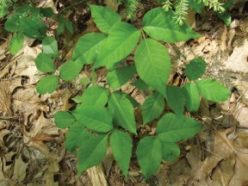Pumping up poison ivy
Boosting carbon dioxide levels makes poison ivy grow faster and become more toxic.
By Emily Sohn
It itches and oozes. With its red bumps, a poison ivy rash can make you miserable.
The potential for misery might get even worse. A new study suggests that rising levels of the gas carbon dioxide in the atmosphere could make poison ivy grow faster and become more toxic.
 |
|
Poison ivy grows unusually fast when carbon dioxide in the atmosphere reaches levels expected in forests by about the year 2050.
|
| J. Blanchard |
“Rising carbon dioxide can favor pests and weeds, those plants we’d least like to see succeed,” says climate-change ecologist Bruce Hungate of Northern Arizona University in Flagstaff.
Large doses of carbon dioxide (CO2) get into the air when people burn coal, oil, natural gas, and other fossil fuels. Carbon dioxide is a greenhouse gas. As it accumulates, the atmosphere traps more heat, and Earth’s climate warms up.
Plants need CO2 to grow. To test whether extra CO2 in the environment leads to extra plant growth, scientists have set up circles of pipes as high as treetops around the world. These pipes spit out either regular air or extra CO2 over a patch of ground. As a result, researchers can compare how plants respond to different atmospheric conditions.
For 6 years, scientists monitored plants that grew near some of these pipes in a Duke University pine forest. They found that, with about 50 percent more CO2 around, poison ivy plants were able to make more food and use water with greater efficiency.
Poison ivy plants that got the CO2 boost produced the same amount of toxic oil, called urushiol, as regular air-bathed plants. With extra CO2, however, more of the urushiol was in a particularly toxic form and more likely to cause rashes.
Poison ivy’s success in the presence of extra CO2 is just one example of how climate change might alter the dynamics of forest ecosystems, scientists say.
With more poison ivy around, it might also become harder to enjoy being in the woods. Lead researcher Jacqueline E. Mohan, for example, had never developed a rash from poison ivy before she started the study. “I get it now,” she says.—E. Sohn
Going Deeper:
Milius, Susan. 2006. Pumped-up poison ivy: Carbon dioxide boosts plant’s size, toxicity. Science News 169(June 3):339. Available at http://www.sciencenews.org/articles/20060603/fob1.asp .
Additional information about research in the Duke Forest can be found at www.env.duke.edu/forest/ (Duke University).
To learn more about the effects of poison ivy, go to kidshealth.org/kid/health_problems/skin/poison_ivy.html (KidsHealth for Kids).
Sohn, Emily. 2006. Plant gas. Science News for Kids (Jan. 18). Available at http://www.sciencenewsforkids.org/articles/20060118/Note2.asp .
______. 2005. Arctic algae show climate change. Science News for Kids (March 9). Available at http://www.sciencenewsforkids.org/articles/20050309/Note2.asp .
______. 2004. A change in climate. Science News for Kids (Dec. 8). Available at http://www.sciencenewsforkids.org/articles/20041208/Feature1.asp .
______. 2003. Slower growth, greater warmth. Science News for Kids (April 30). Available at http://www.sciencenewsforkids.org/articles/20030430/Note2.asp .
Science project idea: Grow different plants in chambers with higher-than-normal levels of carbon dioxide. What effect do elevated levels of carbon dioxide have on how different plants grow?







